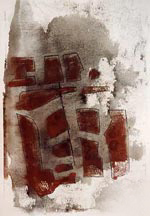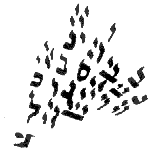![]()
![]()
![]()
![]()
![]()
![]()
![]()
![]()
![]()
A Piece of History: Jews in the Iberian peninsula
In the
year 70 C.E., after the destruction of the Second Temple in Jerusalem
by the Romans,
thousands of Jews fled to several countries in Europe,
Asia and Northern Africa.
We do not have evidence that in those remote times, some of them arrived
in Barcelona.
But in the consecutive relocations, their descendants were living in this city by the mid IX c., as there are references to a Jewish cemetery since before 850's.
Besides tombstones and some jewels,
there is nothing left
of their material culture. None of the five synagogues remain standing. But there is a very rich history worth telling
and revisiting.

Aleph from
illuminated
manuscript
The thirteenth century was the most prosperous period for the Jewish community throughout what we now refer to as Spain.
The size of Barcelona's Call (Jewish quarter) reached 4.000 inhabitants or about 15 percent of the city's population.
Versed in Latin, Greek and Hebrew, Spanish, Catalan or Arabic -depending where they lived-, Jews acted as cultural liaisons between Eastern and Western civilizations, and helped transmit the latest advances in science and the most recent works by Arab philosophers.
Nevertheless, despite this prosperous situation, Jews often suffered ill-treatment and their Christian neighbors did not look favorably upon them.

Barcelona Call
by Devra Wiseman
London
(click to enlarge)
Throughout the centuries,
Jews had been forced to convert to Catholicism.
The 'new Christians'
were usually protected by a Christian patron who offered them his surname.
After the attack to Barcelona's Call in 1391, the newly converted
could hold positions that had been previously forbidden to them.
The Inquisition persecuted those who continued with their Jewish practices, generating the
many autos-da-fe of that time.
This situation worsened in 1492, when the Catholic Kings, Ferdinand of Castille and Isabella of Aragon, ordered the expulsion of those Jews still living on Spanish soil.
(click to enlarge)
From the expulsion in 1492 through
the end of the nineteenth century, there was no Jewish life in
Spain. Jews returned first from the Middle East, later from Morocco, and
during the second half of the twentieth century, from South America.
There
are presently less than 30,000 Jews in Spain and over 20 communities, of which
only a handful have a full time Rabbi.
Barcelona is the only city where
there are four (soon five) synagogues with regular services and a couple of minyanim.
Comunidad Israelita
de Barcelona (CIB), orthodox in orientation, was the first one in peninsular
Spain to build a new community
center.
Comunitat Jueva ATID de Catalunya, is the first egalitarian congregation
in Spain, affiliated with conservative movement MASORTI OLAMI.
Center Chabad Lubavitch and reform congregation Bet Shalom, of later creation, offer other alternatives to Jewish life.

Yet the bush
was not consumed
by Didac Pintor
Barcelona
(click to enlarge)
![]()
